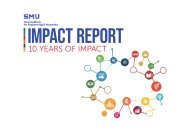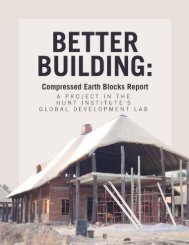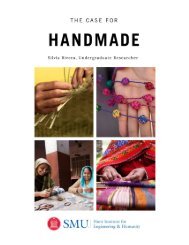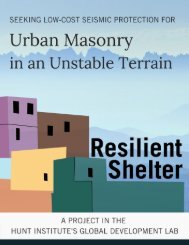Assessment of Rwanda Refugee Camps in the Context of the Villagization Process
Undergraduate researcher for the Hunt Institute for Engineering and Humanity and Engaged Learning Fellow Sienna Dugan, researched secondary sources and primary research through site visits, participatory observation, and interviews with key informants to compile this report which is structured like a case study with additional literature review. All photography is original to the student from her in-field research.
Undergraduate researcher for the Hunt Institute for Engineering and Humanity and Engaged Learning Fellow Sienna Dugan, researched secondary sources and primary research through site visits, participatory observation, and interviews with key informants to compile this report which is structured like a case study with additional literature review. All photography is original to the student from her in-field research.
Create successful ePaper yourself
Turn your PDF publications into a flip-book with our unique Google optimized e-Paper software.
The third commitment is being accomplished in two ways: by assuring that schools located
inside refugee camps follow national curriculum and by upgrading national schools to
accommodate refugee children. Currently, there is an average of 127.4 students per class where
the national average is 85 and the national target is 46.16 Similar statistics show that schools
attended by refugee children have on average worse student to qualified teacher ratios, pupil to
toilet ratios, computer availability and availability of laboratories, then national targets. UNICEF
and ADRA have provide educational material and uniforms to all of the children enrolled. The
World Food Program provides free lunch every day in order to combat high malnutrition rates and
rates of school drop outs.
Commitment four dictates a commitment by the Government of Rwanda to allow 100% of
refugees the ability to buy into the national health insurance. This commitment seeks to remedy
complaints of refugees regarding barriers to healthcare such as the distance to clinics, age
restrictions, limited referrals, and availability of care for those with chronic diseases. Ability to
enroll in the health insurance program will not be granted until the number or refugees is verified.
Objective five broadly provides strategic measures to ensure all objectives are met through
a strategic communication plan. These include: consulting relevant ministries and stakeholders,
raising awareness on the objectives, fundraising, and monitoring and evaluating the overall
strategies.
16 MINEMA. Strategic Plan for Refugee Inclusion 2019-2024. Feb. 2019,
minema.gov.rw/fileadmin/user_upload/STRATEGIC_PLAN_FOR_REFUGEE_INCLUSION_2019-2024.pdf.
25














